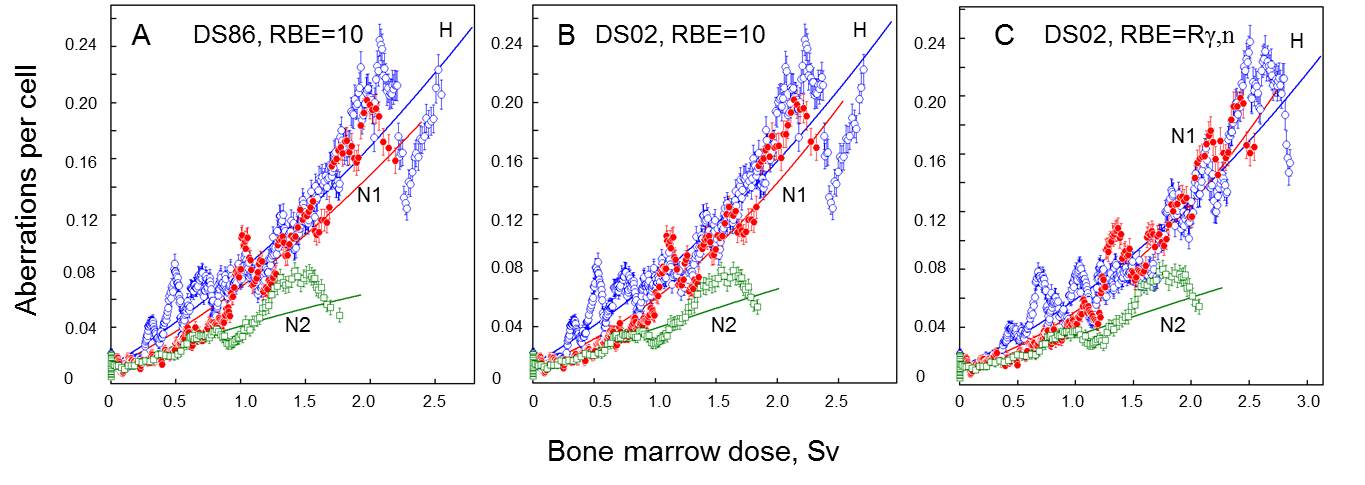
| A-bomb: Commentary on neutron RBE (Sasaki et al. 2006, 2008, 2014, 2016) |
|
Scenario |
|
A-bomb radiation is a mixture of gamma-rays and neutrons. To date, in Radiation Effects Research Foundation (RERF), all biological effects of A-bomb radiation, including chromosome aberrations and cancer/non-cancer risks, have been assessed basing on the neutron dose weighted by constant RBE of 10, i.e., the effective dose DE in Sv is expressed by DE=C+Dg+10~Dn, where Dg and Dn are gamma and neutron dose in tissue kerma in Gy, respectively, and C is dose-independent control value. Recently, this effective dose has been further modified by the dose adjustment factor, Γ, assuming the random dosimetry errors, which is dependent on dose and city. The modified dose is called esurvivor dosef as expressed by DS=C+Γ(Dg+10~Dn) and has been used in the dose-responses of chromosome aberrations and cancer/non-cancer risks. This modification resulted in the dose-response less curvature and the slope steeper, but still remain the city difference. Recently, an alternative approach has been made to solve the city difference by introducing dose-dependent variable RBE of neutrons, RBE=Rg,n. Neutron weighting by variable RBE under the new DS02 dosimetry system and exclusion of factory workers from Nagasaki survivors revealed the identity of two cities in dose responses for chromosome aberrations as well as cancer/leukemia even without dose modification by random dosimetry error strategy. The factory workers were likely to be additionally shielded, probably by working benches. |
|
References |
|
(1) Sasaki, M. S., Endo, S., Ejima, Y., Saito,
I., Okamutra, K., Oka, Y. and Hoshi, M. (2006): Effective dose of A-bomb
radiation in Hiroshima and Nagasaki as assessed by chromosomal effectiveness
of spectrum energy photons and neutrons. Radiat. Environ. Biophys., 45:79-91. |
| Dose-response kinetics: The dose-response kinetics has been reassessed using the RERF chromosome database ecs1993f. The aberration frequencies were fitted to the linear-quadratic model. |

| . | |||||||||||||||||
| Neutron RBE* | City | No. of survivors | Regression coefficients (}S.E.) | Goodness-of-fit | |||||||||||||
| Unexposed** | Exposed | C (~10-2) | Ώ (~10-2Sv-1) | ΐ (~10-2Sv-2) | F-value | p | |||||||||||
| Constant RBE=10 | (1) | H | Hiroshima | 499 | 542 | 1.200}0.052 | 5.691}0.841 | 0.833}0.518 | (1) vs (2) | 10.253 | <0.0001 | ||||||
| (2) | N | Nagasaki: all | 275 | 382 | 1.187}0.107 | 2.451}0.893 | 1.587}0.514 | ||||||||||
| (3) | N1 | Nagasaki: non-factory | (275) | 294 | 1.112}0.104 | 3.495}0.112 | 1.540}0.830 | (1) vs (3) | 2.371 | 0.0937 | |||||||
| (4) | N2 | Nagasaki: factory | (275) | 88 | 1.294}0.078 | 3.220}0.574 | -0.388}0.389 | (3) vs (4) | 22.95 | <0.0001 | |||||||
| Variable RBE=RΑ,n | (5) | H | Hiroshima | 499 | 525 | 1.218}0.077 | 3.703}0.942 | 1.032}0.540 | (5) vs (6) | 4.237 | 0.0146 | ||||||
| (6) | N | Nagasaki: all | 275 | 381 | 1.246}0.097 | 1.440}0.879 | 1.668}0.638 | ||||||||||
| (7) | N1 | Nagasaki: non-factory | (275) | 293 | 1.183}0.103 | 2.122}1.203 | 1.791}0.654 | (5) vs (7) | 1.009 | 0.3647 | |||||||
| (8) | N2 | Nagasaki: factory | (275) | 88 | 1.297}0.076 | 2.661}0.491 | -0.200}0.330 | (7) vs (8) | 25.729 | <0.0001 | |||||||
| *) RBE=10: neutron dose is weighted by dose-independent RBE of 10. RBE=RΑ,n: neutron dose is weighted by dose-dependent RBE. | |||||||||||||||||
| **) In Nagasaki, common control cohort was used for the factory workers, non-factory survivors and combined all survivors. | . | ||||||||||||||||
| . | |||||||||||||||||